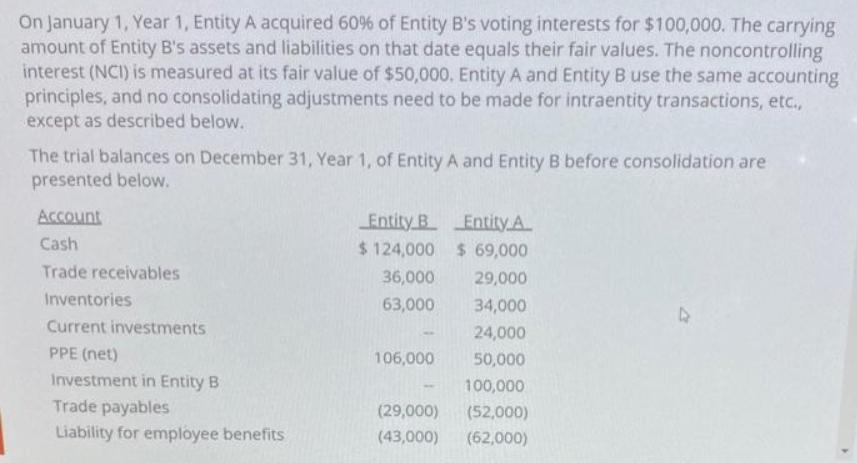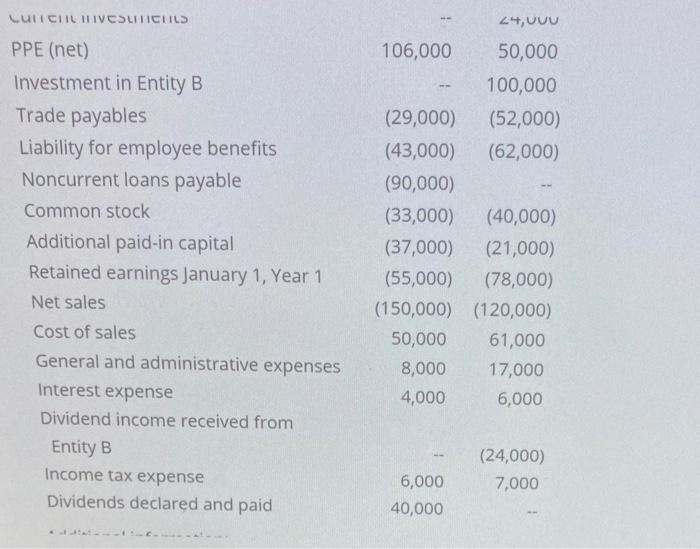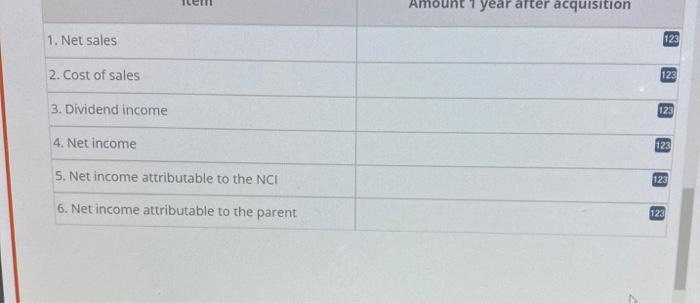Answered step by step
Verified Expert Solution
Question
1 Approved Answer
On January 1, Year 1, Entity A acquired 60% of Entity B's voting interests for $100,000. The carrying amount of Entity B's assets and




On January 1, Year 1, Entity A acquired 60% of Entity B's voting interests for $100,000. The carrying amount of Entity B's assets and liabilities on that date equals their fair values. The noncontrolling interest (NCI) is measured at its fair value of $50,000. Entity A and Entity B use the same accounting principles, and no consolidating adjustments need to be made for intraentity transactions, etc., except as described below. The trial balances on December 31, Year 1, of Entity A and Entity B before consolidation are presented below. Account Cash Trade receivables Inventories Current investments PPE (net) Investment in Entity B Trade payables Liability for employee benefits Entity B $ 124,000 36,000 63,000 106,000 (29,000) (43,000) Entity A $ 69,000 29,000 34,000 24,000 50,000 100,000 (52,000) (62,000) 4 CULTCHIVEstrichts PPE (net) Investment in Entity B Trade payables Liability for employee benefits Noncurrent loans payable Common stock Additional paid-in capital Retained earnings January 1, Year 1 Net sales Cost of sales General and administrative expenses Interest expense Dividend income received from Entity B Income tax expense Dividends declared and paid 24,000 106,000 50,000 100,000 (29,000) (52,000) (43,000) (62,000) (90,000) (33,000) (40,000) (37,000) (21,000) (55,000) (78,000) (150,000) (120,000) 50,000 61,000 17,000 6,000 -- 8,000 4,000 6,000 40,000 (24,000) 7,000 Additional information: In its separate financial statements, Entity A accounts for its investment in the subsidiary (Entity B) according to the cost model. Thus, dividends from the subsidiary are recognized as income. During Year 1, Entity B distributed a cash dividend of $40,000. On December 31, Year 1, Entity A sold on credit an inventory item with a cost of $20,000 to Entity B for $28,000. This item is in Entity B's inventory at year end. Note: To simplify the simulation, items of other comprehensive income are not included. Complete Entity A's year-end consolidated income statement. Enter the appropriate amounts in the designated cells below. Enter all amounts as positive values. If no entry is necessary, enter a zero (0). Amount 1 year after acquisition 1. Net sales 2. Cost of sales 3. Dividend income 4. Net income Item 123 123 123 123 D 1. Net sales 2. Cost of sales 3. Dividend income 4. Net income 5. Net income attributable to the NCI 6. Net income attributable to the parent Amou 1 year after acquisition 123 123 123 123 123 123
Step by Step Solution
★★★★★
3.39 Rating (161 Votes )
There are 3 Steps involved in it
Step: 1
To calculate Entity As yearend consolidated income statement we need to consider the following items ...
Get Instant Access to Expert-Tailored Solutions
See step-by-step solutions with expert insights and AI powered tools for academic success
Step: 2

Step: 3

Ace Your Homework with AI
Get the answers you need in no time with our AI-driven, step-by-step assistance
Get Started


